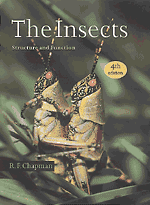Book contents
- Frontmatter
- Contents
- Preface
- Acknowledgments
- PART I The Head, Ingestion, Utilization and Distribution of Food
- PART II The Thorax and Locomotion
- PART III The Abdomen, Reproduction and Development
- PART IV The Integument, Gas Exchange and Homeostasis
- 16 Integument
- 17 Gaseous exchange
- 18 Excretion and salt and water regulation
- 19 Thermal relations
- PART V Communication
- Taxonomic index
- Subject index
19 - Thermal relations
Published online by Cambridge University Press: 05 June 2012
- Frontmatter
- Contents
- Preface
- Acknowledgments
- PART I The Head, Ingestion, Utilization and Distribution of Food
- PART II The Thorax and Locomotion
- PART III The Abdomen, Reproduction and Development
- PART IV The Integument, Gas Exchange and Homeostasis
- 16 Integument
- 17 Gaseous exchange
- 18 Excretion and salt and water regulation
- 19 Thermal relations
- PART V Communication
- Taxonomic index
- Subject index
Summary
Insect systems function optimally within a limited range of temperatures. For a majority of insects, enzyme activity, tissue functioning and the behavior of the whole insect is optimal at a relatively high temperature, often in the range 30–40 °C (see Figs. 3.22, 10.17b). This chapter considers the factors that determine an insect's temperature, how body temperature may be regulated, and how insects cope with extremes of temperature.
DEFINITIONS
Ectothermal – body temperature depends on heat acquired from the environment.
Endothermal – body temperature depends on heat produced by the animal's own metabolism.
Heterothermal – body temperature is sometimes determined by the organism's metabolism (endothermy); at other times it is governed by the environment (ectothermy).
Poikilotherm – an animal whose body temperature is variable and dependent on ambient.
Homeotherm – an animal whose body temperature is constant as a result of endothermy.
BODY TEMPERATURE
Heat gain
Internal heat production
The body temperature of an insect is always a reflection of ambient conditions coupled with any heat that may be produced by metabolic activity. Because the mechanical efficiency of muscles is very low, any muscular activity produces heat, but, in insects, because of the small size of the muscles and the high rate of heat loss from the organism, the effects of muscular activity on body temperature are usually insignificant. The flight muscles, however, are relatively large and oscillate at high frequencies when generating the power needed for flight.
- Type
- Chapter
- Information
- The InsectsStructure and Function, pp. 509 - 530Publisher: Cambridge University PressPrint publication year: 1998
- 5
- Cited by



